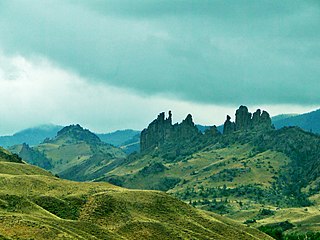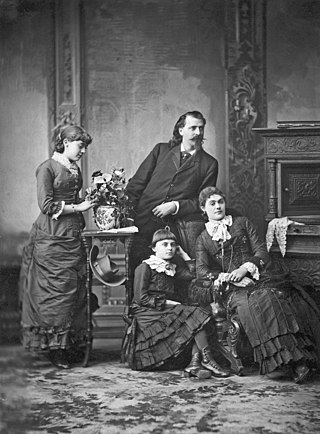
William Frederick Cody, known as "Buffalo Bill", was an American soldier, bison hunter, and showman. He was born in Le Claire, Iowa Territory, but he lived for several years in his father's hometown in modern-day Mississauga, Ontario, Canada, before the family returned to the Midwest and settled in the Kansas Territory.
William Robertson Coe was an insurance, railroad and business executive, a major owner and breeder of Thoroughbred racehorses, as well as a collector of Americana and an important philanthropist for the academic discipline of American Studies.

Buffalo Bill Cody Scenic Byway is in the U.S. state of Wyoming and spans most of the distance from Cody, Wyoming to Yellowstone National Park. The 27.5-mile (44.3 km) scenic highway follows the north fork of the Shoshone River through the Wapiti Valley to Sylvan Pass and the eastern entrance to Yellowstone. Most of the scenic byway is contained within Shoshone National Forest and is also known as US Highway 14 (US 14), US 16 and US 20.

Buffalo Bill Ranch State Historical Park, known as Scout's Rest Ranch, is a living history state park located west of North Platte, Nebraska. The ranch was established in 1878 with an initial purchase of 160 acres south of the Union Pacific tracks by William Cody. The 4,000 acre ranch was sold in 1911 and has been under the management of the Nebraska Game and Parks Commission since 1964. The 25 acre historic state park, added to the National Register of Historic Places in 1978 and designated a National Historic Landmark in 2021, is open weekdays from April to October. The house and outbuildings can be toured, including a museum documenting Cody's life from a Pony Express rider to his Wild West shows.

Buffalo Bill State Park is a public recreation area surrounding the reservoir formed by the Buffalo Bill Dam, an impoundment of the Shoshone River, in Park County, Wyoming. The state park, reservoir and dam were named after William "Buffalo Bill" Cody, who founded the nearby town of Cody and who owned much of the land now occupied by the reservoir and park. The park offers camping, hiking, boating, fishing, and picnicking and is managed by Wyoming Division of State Parks and Historic Sites.

Lookout Mountain Park is a Denver Mountain Park located around 12 miles (20 km) west of downtown Denver overlooking Golden, Colorado. It consists of 65.7 acres (266,000 m2) of evergreen wilderness atop Lookout Mountain, named for its being a favored lookout point of the native Ute Indian tribe. Lookout Mountain Park is the burial site of the internationally famous western frontiersman William Frederick "Buffalo Bill" Cody, and is listed on the National Register of Historic Places.

Buffalo Bill Dam is a concrete arch-gravity dam on the Shoshone River in the U.S. state of Wyoming. It is named after the famous Wild West figure William "Buffalo Bill" Cody, who founded the nearby town of Cody and owned much of the land now covered by the reservoir formed by its construction. The dam is part of the Shoshone Project, successor to several visionary schemes promoted by Cody to irrigate the Bighorn Basin and turn it from a semi-arid sagebrush-covered plain to productive agricultural land. Known at the time of its construction as Shoshone Dam, it was renamed in 1946 to honor Cody.

The Sheridan Inn is a historic hotel in Sheridan, Wyoming. Designed by the architect Thomas R. Kimball of Omaha, Nebraska in 1893, it was constructed by the Chicago, Burlington, and Quincy Railroad as part of its development program in Wyoming associated with extension of the railway. Equipped with the first bathtubs and electric lights in that part of Wyoming, the inn was considered the "finest hotel" between Chicago and San Francisco. It was declared a National Historic Landmark in 1964.

Pahaska Tepee is William "Buffalo Bill" Cody's old hunting lodge and hotel in the U.S. state of Wyoming. It is located 50 miles (80 km) west of the town of Cody and two miles from the east entrance to Yellowstone National Park.
The T E Ranch Headquarters, near Cody, Wyoming, is a log ranch house that belonged to buffalo hunter and entertainer Buffalo Bill Cody (1846–1917). The house may have originally been built by homesteader Bob Burns prior to 1895, when Cody acquired the ranch. Cody expanded the ranch to about eight thousand acres (32 km2), using the T E brand for his thousand head of cattle.
The Elephant Head Lodge is a guest lodge on the road to, and only 12 miles from, the east entrance of Yellowstone National Park, in Shoshone National Forest. The ranch includes two main lodges surrounded by support buildings and guest cabins. Beginning in 1926, the Elephant Head was developed by Buffalo Bill Cody's niece, Josephine Thurston and her husband Harry W. Thurston. The lodge was named after a distinctive rock formation that rises above the property.

The Buffalo Bill Boyhood Home was built by Isaac Cody, the father of Buffalo Bill Cody in 1841 at LeClaire, Iowa. The house was purchased as a tourist attraction by the Chicago, Burlington and Quincy Railroad and was moved to Cody, Wyoming, Buffalo Bill's adopted hometown, in 1933.

Buffalo Bill - The Scout is a bronze statue of a mounted rider outside the Buffalo Bill Historical Center in Cody, Wyoming, that was placed in 1924 to commemorate the town's most famous resident and de facto founder, Buffalo Bill Cody. Originally in open land on the western outskirts of Cody, the statue now stands at the end of Sheridan Avenue, which became the town's main thoroughfare as Cody grew to the west. The project was initiated by Buffalo Bill Cody's niece, Mary Jester Allen, who had established the basis of what would become the Buffalo Bill Historical Center. A New Yorker, she persuaded heiress and artist Gertrude Vanderbilt Whitney to sculpt the piece.

The Downtown Cody Historic District is the historic core of Cody, Wyoming, USA. "Historic" here refers to the early twentieth century, as Cody was not incorporated until 1901. Most of the commercial district was built between 1901 and the 1930s. The district extends along Sheridan Avenue for two blocks, with buildings of brick and local sandstone with storefront display windows. The chief building in the district is the Irma Hotel, individually listed on the National Register of Historic Places.
The Stock Center in Cody, Wyoming was built in 1927 as the original home of the Buffalo Bill Museum, serving in that purpose until the museum was relocated to a new complex across the street. The log structure is intended to suggest a stockman's log cabin, rendered on a large scale.

The Paul Stock House was the residence of three-time Cody, Wyoming mayor, oilman, rancher and philanthropist Paul Stock. Built in 1945–46, the house is on a secluded site on a bluff overlooking the Shoshone River, with a view of Heart and Cedar Mountains on the edge of Cody. The house was designed by Leon Goodrich, who was fired after two months because Stock didn't want to be told what to do by the architect. Stock took over the management of the project from then on, building the rambling house in the Spanish Eclectic style. While Stock oversaw the project himself, he kept nearly all of Goodrich's design intact.
Thomas C. Molesworth (1890–1977) was an American furniture designer who was a significant figure in the creation of a distinctly Western style of furniture and accessories, using hides, horn and natural wood. Molesworth's style drew from the Arts and Crafts Movement and from vernacular design characteristics of western American ranches and farms. He is credited with popularizing the "cowboy furniture" style. To produce his designs, Molesworth operated the Shoshone Furniture Company from 1931 to 1961 in Cody, Wyoming with his wife, LaVerne Johnston Molesworth.
The Chamberlin Inn is a historic Cody, Wyoming hotel and landmark, known famously as the hotel where Ernest Hemingway stayed and finished his manuscript, Death in the Afternoon. Located at 1032 12th Street in downtown Cody, Wyoming the small boutique hotel is 21 units made up of a series of suites, rooms, cottage and garden studios, as well as the Court House Residence, all within a brick and wrought iron courtyard.

Louisa Maud Frederici Cody was the wife of William F. "Buffalo Bill" Cody. She married on March 6, 1866, on her family farm in Arnold, Missouri, and remained in a rocky relationship for 51 years until Cody's death in 1917. The couple had met when Cody traveled to St. Louis due to his Union Army duties at the close of the Civil War. They married soon after, the wedding taking place shortly after their interactions in 1865, with Cody taking time out from scouting and horse-driving to marry Louisa. Louisa, often referred to as "Lulu" by her husband, was a proud woman who would not simply grant Cody a divorce in 1904, which led to trial in 1905. The case was given in Louisa's favor after a judge deemed "incompatibility was not a grounds for divorce."
Valentine (Val) Monroe Kirk (1883–1947), was an oil exploration pioneer and rancher in Wyoming and Montana. Generally known as "V.M." or going simply by his surname, Kirk was born in Greene County, Tennessee on June 10, 1883, to Joseph Wiley Kirk (1839–1921) and Elizabeth C. "Katie" Drake (1849–1887). Records are not definitive—including evidence such as an old family cemetery and limited provenance of an antique desk thought to be owned by his great-grandfather Captain Joseph Isaac Kirk (1755–1821)—but Valentine descended from five prior generations of Kirks who homesteaded the area northeast of Knoxville, Tennessee as early as the 1730s. Kirk's great-granduncle, John M. Kirk Junior committed the notorious May 1788 murder of Native American leaders including Old Tassel, "First Beloved Man" of the Overhill Cherokee.















